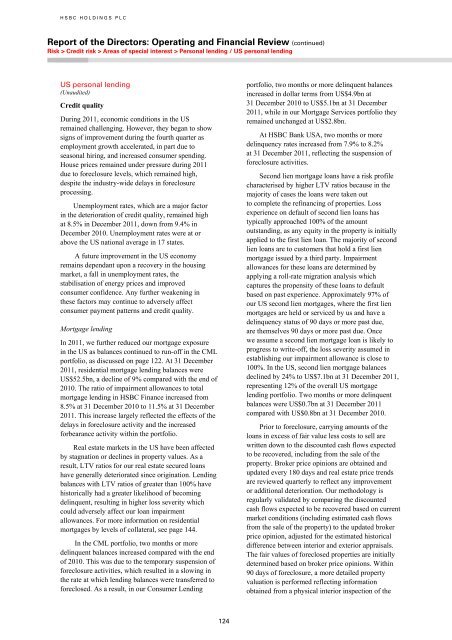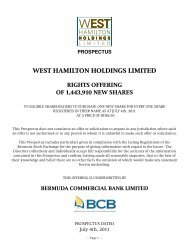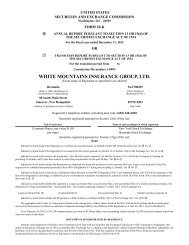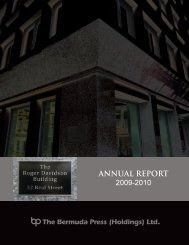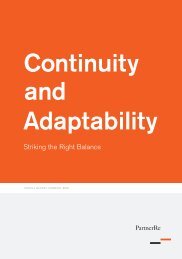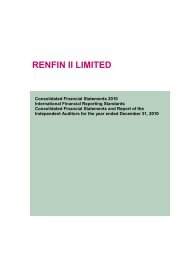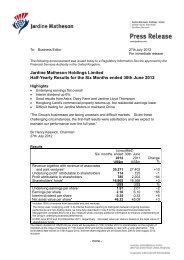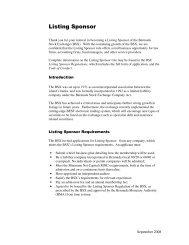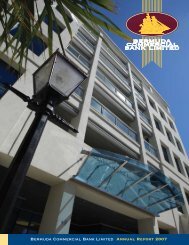Annual Report and Accounts 2011 - Bermuda Stock Exchange
Annual Report and Accounts 2011 - Bermuda Stock Exchange
Annual Report and Accounts 2011 - Bermuda Stock Exchange
You also want an ePaper? Increase the reach of your titles
YUMPU automatically turns print PDFs into web optimized ePapers that Google loves.
HSBC HOLDINGS PLC<br />
<strong>Report</strong> of the Directors: Operating <strong>and</strong> Financial Review (continued)<br />
Risk > Credit risk > Areas of special interest > Personal lending / US personal lending<br />
US personal lending<br />
(Unaudited)<br />
Credit quality<br />
During <strong>2011</strong>, economic conditions in the US<br />
remained challenging. However, they began to show<br />
signs of improvement during the fourth quarter as<br />
employment growth accelerated, in part due to<br />
seasonal hiring, <strong>and</strong> increased consumer spending.<br />
House prices remained under pressure during <strong>2011</strong><br />
due to foreclosure levels, which remained high,<br />
despite the industry-wide delays in foreclosure<br />
processing.<br />
Unemployment rates, which are a major factor<br />
in the deterioration of credit quality, remained high<br />
at 8.5% in December <strong>2011</strong>, down from 9.4% in<br />
December 2010. Unemployment rates were at or<br />
above the US national average in 17 states.<br />
A future improvement in the US economy<br />
remains dependant upon a recovery in the housing<br />
market, a fall in unemployment rates, the<br />
stabilisation of energy prices <strong>and</strong> improved<br />
consumer confidence. Any further weakening in<br />
these factors may continue to adversely affect<br />
consumer payment patterns <strong>and</strong> credit quality.<br />
Mortgage lending<br />
In <strong>2011</strong>, we further reduced our mortgage exposure<br />
in the US as balances continued to run-off in the CML<br />
portfolio, as discussed on page 122. At 31 December<br />
<strong>2011</strong>, residential mortgage lending balances were<br />
US$52.5bn, a decline of 9% compared with the end of<br />
2010. The ratio of impairment allowances to total<br />
mortgage lending in HSBC Finance increased from<br />
8.5% at 31 December 2010 to 11.5% at 31 December<br />
<strong>2011</strong>. This increase largely reflected the effects of the<br />
delays in foreclosure activity <strong>and</strong> the increased<br />
forbearance activity within the portfolio.<br />
Real estate markets in the US have been affected<br />
by stagnation or declines in property values. As a<br />
result, LTV ratios for our real estate secured loans<br />
have generally deteriorated since origination. Lending<br />
balances with LTV ratios of greater than 100% have<br />
historically had a greater likelihood of becoming<br />
delinquent, resulting in higher loss severity which<br />
could adversely affect our loan impairment<br />
allowances. For more information on residential<br />
mortgages by levels of collateral, see page 144.<br />
In the CML portfolio, two months or more<br />
delinquent balances increased compared with the end<br />
of 2010. This was due to the temporary suspension of<br />
foreclosure activities, which resulted in a slowing in<br />
the rate at which lending balances were transferred to<br />
foreclosed. As a result, in our Consumer Lending<br />
portfolio, two months or more delinquent balances<br />
increased in dollar terms from US$4.9bn at<br />
31 December 2010 to US$5.1bn at 31 December<br />
<strong>2011</strong>, while in our Mortgage Services portfolio they<br />
remained unchanged at US$2.8bn.<br />
At HSBC Bank USA, two months or more<br />
delinquency rates increased from 7.9% to 8.2%<br />
at 31 December <strong>2011</strong>, reflecting the suspension of<br />
foreclosure activities.<br />
Second lien mortgage loans have a risk profile<br />
characterised by higher LTV ratios because in the<br />
majority of cases the loans were taken out<br />
to complete the refinancing of properties. Loss<br />
experience on default of second lien loans has<br />
typically approached 100% of the amount<br />
outst<strong>and</strong>ing, as any equity in the property is initially<br />
applied to the first lien loan. The majority of second<br />
lien loans are to customers that hold a first lien<br />
mortgage issued by a third party. Impairment<br />
allowances for these loans are determined by<br />
applying a roll-rate migration analysis which<br />
captures the propensity of these loans to default<br />
based on past experience. Approximately 97% of<br />
our US second lien mortgages, where the first lien<br />
mortgages are held or serviced by us <strong>and</strong> have a<br />
delinquency status of 90 days or more past due,<br />
are themselves 90 days or more past due. Once<br />
we assume a second lien mortgage loan is likely to<br />
progress to write-off, the loss severity assumed in<br />
establishing our impairment allowance is close to<br />
100%. In the US, second lien mortgage balances<br />
declined by 24% to US$7.1bn at 31 December <strong>2011</strong>,<br />
representing 12% of the overall US mortgage<br />
lending portfolio. Two months or more delinquent<br />
balances were US$0.7bn at 31 December <strong>2011</strong><br />
compared with US$0.8bn at 31 December 2010.<br />
Prior to foreclosure, carrying amounts of the<br />
loans in excess of fair value less costs to sell are<br />
written down to the discounted cash flows expected<br />
to be recovered, including from the sale of the<br />
property. Broker price opinions are obtained <strong>and</strong><br />
updated every 180 days <strong>and</strong> real estate price trends<br />
are reviewed quarterly to reflect any improvement<br />
or additional deterioration. Our methodology is<br />
regularly validated by comparing the discounted<br />
cash flows expected to be recovered based on current<br />
market conditions (including estimated cash flows<br />
from the sale of the property) to the updated broker<br />
price opinion, adjusted for the estimated historical<br />
difference between interior <strong>and</strong> exterior appraisals.<br />
The fair values of foreclosed properties are initially<br />
determined based on broker price opinions. Within<br />
90 days of foreclosure, a more detailed property<br />
valuation is performed reflecting information<br />
obtained from a physical interior inspection of the<br />
124


